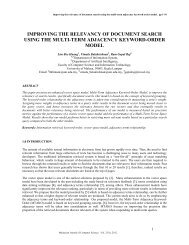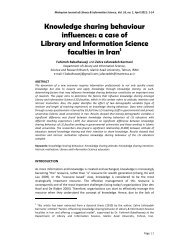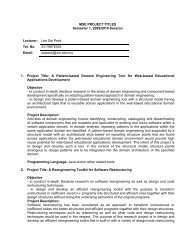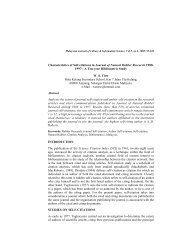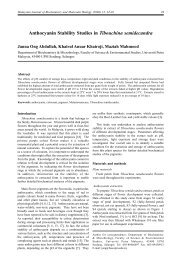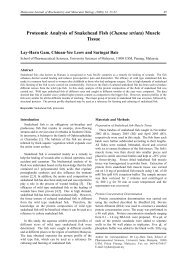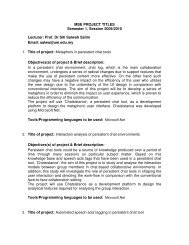DESIGN AND IMPLEMENTATION OF A PRIVATE AND PUBLIC KEY ...
DESIGN AND IMPLEMENTATION OF A PRIVATE AND PUBLIC KEY ...
DESIGN AND IMPLEMENTATION OF A PRIVATE AND PUBLIC KEY ...
You also want an ePaper? Increase the reach of your titles
YUMPU automatically turns print PDFs into web optimized ePapers that Google loves.
Design and Implementation of a Private and Public Key Crypto Processor for Next-Generation IT Security Applications pp. 29 - 45Table 1 shows the performance of AES crypto processor. This AES processor needs 43 clock cycles for singleblock of encryption process. However, for the decryption process, 86 clock cycles are needed for first blockdecryption process due to the key derivation process. From second block until last block, the clock cycles needed isthe same as the encryption process, that is, 43 clock cycles.FeaturesSpeedAreaLatencyTable 1: Performance of AES processorAES Processor (128-bit)297 Mbit/s with 100 MHz clock rate4584 LEs (Logic Elements)43 clock cycles (encryption)86 clock cycles (for first 128 bit block in decryption)Table 2: Performance of RSA processorFeaturesRSA Processor (1024-bit)RSA key length1024-bitsf max100.25 MHzArea12881 LEs ( ≈ 200,00 gates)Encryption (5-bits) with 66 MHz 0.25ms (4000 op/s)Decryption (1024-bits) with 66Mhz 31.93ms (31 op/s)Table 2 shows the performance of RSA crypto processor for modulus length (key length) of 1024-bit, while Table 3shows the area and timing performance of ECP processor. The ECP processor implements the binary field GF(2 163 )in polynomial basis representations as the basis of binary field arithmetic. It supports both trinomial andpentanomial as recommended by IEEE and NIST [20]. Montgomery point multiplication algorithm in projectivecoordinate is chosen. For this performance evaluation purposes, the elliptic curve system domain parameters overF 2 m associated with a Koblitz Curve sect163k1 [20] is implemented. The Digit Size is the number of bits of LSDmultiplier operand processed in parallel, and it can be varied to achieve the trade-offs between speed, area, powerconsumption, and other performance metrics. Register usage in the table refers to the programmable register in eachLEs. As can be seen from Table 3, processing time for each operation decreases as the digit size of the LSDmultiplier increases. However, larger digit size also causes modest reduction of maximum operating frequency ineach case.DigitSize(bits)F max(MHz)Table 3: Area Performance of ECC processorPoint Multiplication Point Addition LogicClockClockElementsop/secop/secCycleCycle(LEs)Registers8 115 26445 4348 813 141451 2994 109516 110 16599 6626 705 156028 4323 117932 105 11685 8985 651 161290 5801 119464 95 8711 10905 617 153970 9792 1225Table 4 shows the area and timing performance of SHA-1 crypto processor. The input is a single block of 512-bitmessage after padding function according to FIPS PUB 180-1 standard [15]. The output is a 160-bit message digestof the single block message after hashing function. The SHA-1 crypto processor is based on systolic architecture.Table 4: Area and timing performance of SHA-1 processorFeaturesSHA Processorf max100 MhzSpeed 0.83 x 10 6 blocks/s (1 block = 512-bit )Latency 120 clock cycles (for each 512-bit input block)Area1194 LEs42Malaysian Journal of Computer Science, Vol. 19(1), 2006



